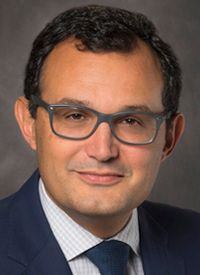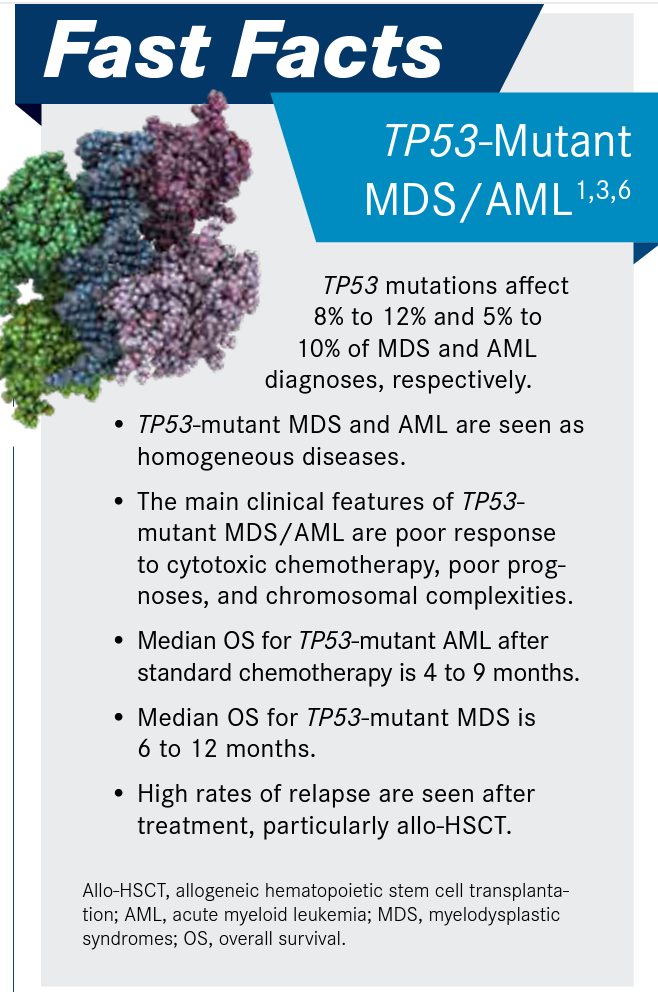Publication
Article
Overcoming Clinical Challenges Associated With TP53-Mutant MDS, AML
Author(s):
TP53-mutant myelodysplastic syndromes and acute myeloid leukemia represent a molecularly distinct, poor-risk patient subgroup frequently associated with complex karyotypes, high propensity for relapse, and inferior overall survival.
Guillermo Garcia-Manero, MD

TP53-mutant myelodysplastic syndromes (MDS) and acute myeloid leukemia (AML) represent a molecularly distinct, poor-risk patient subgroup frequently associated with complex karyotypes, high propensity for relapse, and inferior overall survival.1,2
Across TP53-altered MDS and AML, standard therapies for wild-type disease have been of minimal benefit, but a wave of investigational agents currently in development offers promise for patients with TP53-altered malignancies, which affect 8% to 12% and 5% to 10% of patients with MDS and AML, respectively.1,3 In contrast with wild-type, FLT3-, and IDH1/2-mutant MDS and AML, at present, no agents are indicated specifically for TP53-mutant disease.4
TP53 gene mutations or chromosome 17 loss resulting in TP53 deletion impair function of the TP53 tumor suppressor protein, which regulates DNA repair and cell division.5 TP53 mutations are the most common genetic alteration in oncology, presenting in approximately 50% of all invasive malignancies, and are the most powerful negative prognostic covariate in hematological cancers specifically.6
Clinical Features of MDS/AML
While the tendency is to think about MDS and AML as 2 different entities, the clinical features of TP53-mutant MDS and AML frequently overlap, according to Guillermo Garcia-Manero, MD, professor, chief of the Section of Myelodysplastic Syndromes, and deputy chair of Translational Research in the Department of Leukemia in the Division of Cancer Medicine at The University of Texas MD Anderson Cancer Center in Houston. “The characteristics of patients with AML with a TP53 mutation are very, very similar to those of patients with high-risk MDS with the same molecular and cytogenetic characteristics,” Garcia-Manero said in an interview with OncologyLive®.
To be classified as MDS, disease must meet 1 of the following decisive criteria: dysplasia (≥ 10% in 1 or more of the 3 major bone marrow lineages), a blast count of 5% to 19%, or an observable MDS-associated karyotype, such as deletion 5q (del[5q]), del(20q), +8, and or -7/del(7q).1 Notably, del(5q) is the most commonly observed aberration in complex karyotypes.7 Whether the chromosomal abnormality is isolated or part of a complex karyotype in MDS or AML, del(5q) is strongly associated with concomitant TP53 mutations.1 Existing evidence has shown that TP53 mutations are predictors of poor outcomes with lenalidomide (Revlimid) in higher-risk patients with MDS and del(5q).1,8 Lenalidomide was approved in December 2005 for patients with transfusion-dependent anemia to low- or intermediate-1–risk MDS associated with a del(5q) abnormality with or without additional cytogenetic aberrances.9
Diagnoses of AML are generally made in the presence of 20% or more blasts in the marrow or peripheral blood, per the 2016 World Health Organization classification of AML, but diagnoses can still be made when blasts below 20% are seen in patients with recurrent cytogenetic abnormalities created by reciprocal translocations (t) or inversions (inv) such as t(15;17), t(8;21), t(16;16), or inv(16).2 However, the phenotypical similarity of TP53-mutant MDS and AML has led the field to perceive bone marrow blast percentage as an arbitrary mode of distinction, Garcia-Manero said. Further, many clinicians now view these 2 molecularly specific malignancies as “a homogeneous disease entity,” according to Hunter et al.3
TP53-altered MDS and AML are jointly associated with 3 main characteristics: low response to chemotherapy, chromosomal complexity, and dismal prognosis.3,6 “Finding this mutation is very important to treatment selection because we tend to use lower-intensity approaches that are often better tolerated and more effective than conventional higher doses of chemotherapy,” Garcia-Manero said. “We see that patients with this mutation [are typically] more sensitive to lower-intensity type of chemotherapy, such as hypomethylating agents.”
Hypomethylating agent (HMA) therapy is the standard of care (SOC) for patients with higher-risk MDS. However, TP53-mutant disease treated with HMAs infrequently achieves durable clonal suppression and typically has poor OS.6 The efficacy of standard treatment is commensurately lacking in AML. For decades, induction chemotherapy with cytotoxic agents, including anthracyclines and cytarabine, has been the SOC for patients with AML who are healthy enough to receive systemic treatment.3
However, TP53 mutations, which confer resistance to cytotoxic therapy, strongly correlate with inferior responses to induction chemotherapy. The complete response rate for TP53-mutant, induction chemotherapy–treated AML is from 20% to 40% with high relapse rates; median OS ranges from 4 to 9 months. Despite minimal responses and short survival, patients with TP53-altered AML tend to fare even worse than those who received standard systemic therapy, indicating that SOC treatment should still be considered for these patients, despite the therapeutic prognostic trends observed in the presence of a TP53 mutation.3
Beyond HMAs and chemotherapy, TP53 alterations also complicate the pursuit of allogeneic hematopoietic stem cell transplantation (allo-HSCT).3,6 Across de novo MDS and therapy-related MDS, TP53 is the only somatic gene mutation to predict not only inferior OS but also suboptimal benefit from allo-HSCT.10 Poor long-term outcomes seen with allo-HSCT in TP53-mutant AML have discouraged its use in this patient subgroup, with available data demonstrating posttransplant relapse rates of 40% and 50% at 6 months and 100 days after allo-HSCT, respectively.3
“The rate of relapse is significantly higher in patients with TP53 mutations. This is an important point because the toxicity [as a result of the transplant] could be potentially severe. When you [perform transplants in] patients with TP53 mutations with the standard of care, the relapse rate posttransplant is also very, very high, which suggests that we’re not just talking about resistance. Perhaps the TP53 mutation affects the stem cell–like part of the disease that is very difficult to control with chemotherapy,” Garcia-Manero said.
TP53-mutant MDS and AML are also marked by chromosomal complexities, including complex karyotype (CK), which refers to the presence of 3 or more cytogenetic abnormalities. CK is regarded as a highly adverse prognostic marker that is identified in approximately 10% of MDS diagnoses and has been associated with MDS progression to AML and inferior OS.6,11 TP53 mutations are frequently found in tandem with a CK in MDS and AML and are associated with the worst prognoses when they co-occur.3 “Because the TP53 gene has a role in maintaining the integrity of the genome, when the function of the gene is disrupted, it’s not uncommon to see multiple chromosomal aberrations that are associated with poor prognosis and resistance to therapy,” Garcia-Manero said.
TP53-Mutant MDS/AML

Surmounting Resistance, Poor Response
Eprenetapopt (APR-246), an experimental small molecule manufactured by Aprea Therapeutics, Inc and magrolimab (formerly Hu5F9-G4), an anti-CD47 monoclonal antibody developed by Gilead Sciences, Inc, are 2 agents under investigation for TP53mutant MDS and AML.5,10 “Eprenetapopt is a drug that binds to the TP53 protein and seems to be stabilizing its function. Early reports from clinical trials here in the United States and Europe are showing a high response rate with eprenetapopt in combination with decitabine,” Garcia-Manero said.
Eprenetapopt reactivates mutant TP53 proteins by restoring wild-type TP53 conformation and function to induce programmed cell death in patients with TP53-altered disease.5 The agent’s actionability in TP53mutant MDS is being tested in an ongoing randomized phase 3 trial (NCT03745716) of frontline eprenetapopt with azacitidine (Vidaza) versus azacitidine alone in 154 patients.12
The pivotal study was initiated after eprenetapopt showed encouraging activity with an acceptable safety profile when coadministered with azacitidine in an earlier-stage trial. Data from the phase 1b/2 study (NCT03072043) that provided the impetus for the phase 3 investigation demonstrated the capacity of the eprenetapopt-containing regimen to induce high response rates across subpopulations. The overall response rate (ORR), assessed by 2006 International Working Group criteria for MDS, was 87% among the 45 patients evaluable for response. When stratified by MDS/AML and MDS/myeloproliferative neoplasm, the ORR was 88% and 75%, respectively. More than half of patients in the general population (53%) experienced a complete response (CR); 61% of the 33 patients with MDS achieved a CR. Further, a TP53 mutation, which was identified in 62% of enrolled patients, was predictive for a higher CR rate (69% vs 25%; P = .006) with a trend for higher ORR (93% vs 75%; P = .17). The study enrolled 55 patients with higher-risk MDS, MDS/myeloproliferative neoplasm, or oligoblastic AML who had not previously received an HMA.12
Like eprenetapopt, which currently holds FDA breakthrough therapy, fast track, and orphan drug designations in MDS, magrolimab is also “showing very significant activity in TP53-mutant MDS when combined with decitabine,” said GarciaManero. “It’s possible that at some point maybe next year, we will have results for these 2 compounds, which could potentially improve cure rates in this group of patients.”
The potential viability of magrolimab in the TP53-altered MDS/AML treatment landscape is supported by phase 1b data (NCT03248479) demonstrating the tolerability and durability of the first-in-class therapy tolerability when added to azacitidine. Magrolimab exerts its anticancer activity by targeting CD47, an immune checkpoint on the surface of macrophages that is overexpressed in myeloid malignancies.13 Efficacy data presented at the 2020 American Society of Clinical Oncology Virtual Scientific Program showed that the combination induced the same best ORR (75%) in the subgroup of 12 patients with TP53-mutant AML and a separate subgroup of patients with TP53-mutant MDS (n = 4).10
Forty-two percent of patients in the AML cohort and 50% of patients in the MDS group achieved a CR. After a median follow-up of 8.8 months and 7.0 months in the AML and MDS subgroups, respectively, the estimated 6-month survival was highest among patients with MDS (91% vs 100%).
“The follow-up is not that long, so we don’t know the durability of these responses and the impact on overall survival, but we believe that these are very active compounds that could be used to treat patients with these diseases before and after transplant,” Garcia-Manero said. The phase 1b data have since led the FDA to grant magrolimab a breakthrough therapy designation for patients with newly diagnosed MDS.14
New Frontiers for TP53-Mutant MDS/AML
If respective, ensuing trials of eprenetapopt and magrolimab confirm the benefit seen in earlier-stage studies, the TP53-mutant MDS and AML armamentarium could gain the first FDA-approved therapies indicated specifically for TP53-altered disease.
It is not unreasonable to speculate that either experimental agent could enrich not only the treatment portfolio but also combination strategies in this space, Garcia-Manero said.
“It’s likely that these compounds could be combined with hypomethylating agents and with other drugs like BCL-2 inhibitors such as venetoclax [Venclexta], so we may see triplets of these drugs that could be quite active,” he observed.
If approved, eprenetapopt and magrolimab could later become critical components of a concept that Garcia-Manero and colleagues refer to as “total therapy,” which involves improving pretransplant treatment to increase the response rate, propelling more patients to allo-HSCT, and administering posttransplant therapy in a manner akin to maintenance treatment that will “hopefully result in improved outcomes,” GarciaManero said. “We’re starting to think a lot about how to implement these kinds of therapies after transplant.”










